Wrap a God's Eye

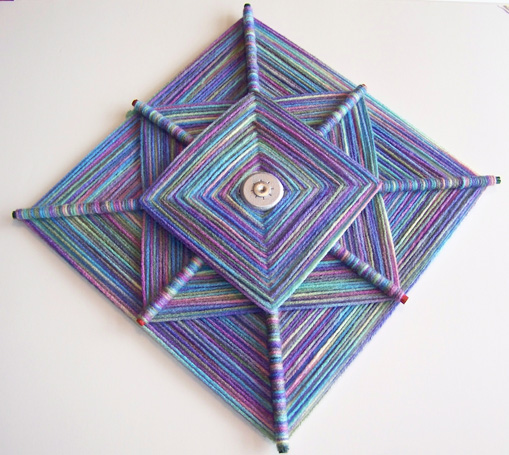 Also known as an Ojo de Dios (pronounced Oh-ho day
DEE-ohs), this traditional Mexican ornament is made by wrapping yarn around two
sticks made into a cross shape. The simple weaving is thought to have
originated with the Huichol Indians of Mexico, but God's Eyes have been found
in Africa and in the Far East, as well. Symbolizing the loving, watchful eye of
a god, the ancient design is thought to bring good luck.
Also known as an Ojo de Dios (pronounced Oh-ho day
DEE-ohs), this traditional Mexican ornament is made by wrapping yarn around two
sticks made into a cross shape. The simple weaving is thought to have
originated with the Huichol Indians of Mexico, but God's Eyes have been found
in Africa and in the Far East, as well. Symbolizing the loving, watchful eye of
a god, the ancient design is thought to bring good luck.
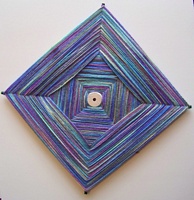 In the Huichol culture, a child's birth is
celebrated by the father weaving a central eye around the sticks, and then an
eye in the form of a new color is added each year until the child is five years
old. Originally placed on altars to watch over the worshipers, the weavings
eventually were hung in homes in hopes of blessing children with good health
and long lives. Today, God's Eyes are found in cultures all over the world, and
people often use them to decorate Christmas trees.
In the Huichol culture, a child's birth is
celebrated by the father weaving a central eye around the sticks, and then an
eye in the form of a new color is added each year until the child is five years
old. Originally placed on altars to watch over the worshipers, the weavings
eventually were hung in homes in hopes of blessing children with good health
and long lives. Today, God's Eyes are found in cultures all over the world, and
people often use them to decorate Christmas trees.
A common way to create a God's Eye is to wrap yarn on craft sticks,
but we can reuse an old Tinkertoy spool and some rods to make a larger and more
elaborate one. Created in 1914 by stonemason Charles Pajeau and his partner
Robert Petit, the Tinkertoy Construction Set was invented after Pajeau watched
children play with pencils and empty spools of thread.
The main parts of the toy include a flat, wooden spool that has holes
drilled around the outside and one through the middle, and wooden rods or
sticks. Popular since the day it was introduced, the toy is among 36 in the
National Hall of Fame Toy Museum. Creating a God's Eye from old Tinkertoys and
using scrap yarn is a good way to help save natural resources, energy, and
landfill space.
You Will Need:
- Tinkertoy spool with 8 holes
- 4-Tinkertoy rods-1/4 inch by 7 and 3/8 inches
- 4- Tinkertoy rods-1/4 inch by 5 inches
- Scrap yarn
- Bead or button
- Scissors
- Hot glue gun
- Acrylic paint (optional)
- Paint brush (optional)
- Jar lid or plastic container (optional)
- Newspaper (optional)
How to:
| To make a traditional God's Eye, only
five colors of yarn and two sticks are used. However, it's possible to make a
more unusual, layered ornament creating it with Tinkertoys and variegated
yarn. |
| This type of fiber has many colors on
one skein or length of yarn, and they change slightly from one color to
another. For example, dark red may fade to rose, which fades to pink, and
finally ends up as a length of white
|
| Since using variegated yarn will
automatically make the eyes change to another color, it won't be necessary to
knot the yarn except at the beginning and end of all the weaving. The example
shown here was made using this type of yarn. |
| If you use a wooden spool for the God's
Eye's center, you'll need to paint it before weaving. Choose a color that goes
well with the yarn you've selected. Working on the newspaper, squeeze a small
amount of paint into a jar lid or plastic container and paint the entire spool.
Allow it to dry before proceeding. If the spool is made of colored plastic,
just go to the next step. |
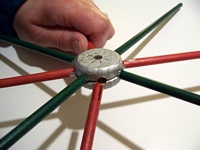 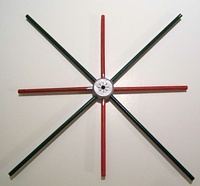 |
To make the weaving framework, firmly place the
sticks into the holes, as shown. Whether you make a God's Eye with variegated
or plain yarn, both start the same way. Tie the end of the yarn onto a short
stick next to the spool. |
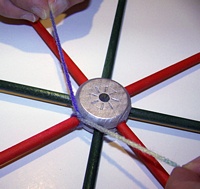 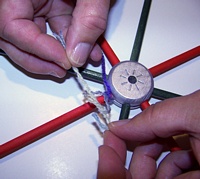 |
Divide the end in half, and tie the tails as if you
were knotting a shoelace. Now skip the long stick and move in a clockwise
direction to the next short one on your right. Begin weaving by wrapping or
going around it one time, as shown. |
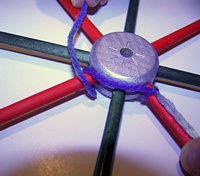 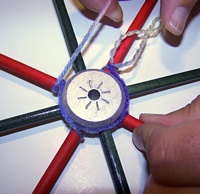 |
Turn or rotate the framework to your left. Skipping
the long stick, proceed to the next short one on your right, and wind around it
once. Continue doing this skipping and winding process until you've woven
around all four, short rods. |
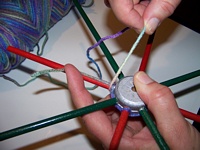 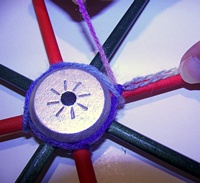 |
When you come to the stick on which you first tied
the yarn, lay the tail out onto the rod, holding it down with a finger, as
shown. Wrap around the tail or loose end each time you come to it, catching the
yarn in the weaving. |
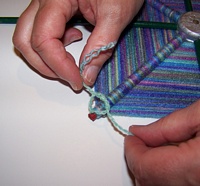 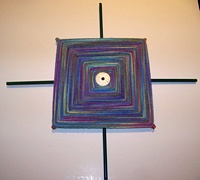 |
After you've woven around the four, short rods many
times and come to the ends of the sticks, finish the weaving by tying the end
of the yarn onto the last stick. As before, unwind the end, tie the tails to
make the final knot, and clip the extra yarn. |
| Now turn the framework over, and begin
weaving on the long sticks on the other side. As before, tie the end onto a
stick next to the spool, divide the tail in two, and knot it. Rotate the
framework one time to the left, and proceed to the next long stick, going
around it once. |
Then go on to the next long rod, wrapping the yarn
as before. Continue weaving the God's Eye until it meets the shape you wove on
the short sticks. When you've completed the eye and and come to the end of the
last stick, knot the yarn and clip the tail. |
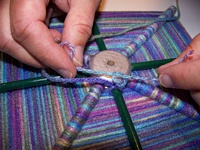 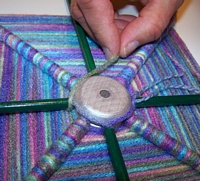 |
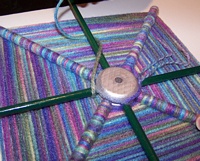 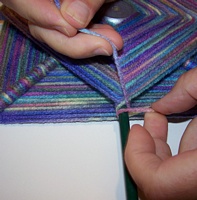 |
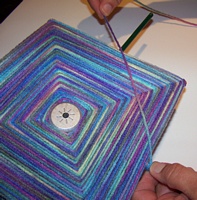 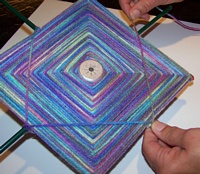 |
To finish the weaving, turn the framework over
again, and knot the yarn onto a long stick next to the first weaving you
completed on the short sticks. Moving in a clockwise direction, wrap the yarn
around the next long stick one time and proceed to the next one. Continue
weaving by going around each stick once until you come to the end of the last
long stick. Finish the weaving by tying the tail in a knot, and clip the extra
yarn. To display, hang on a picture framing hook or nail. |
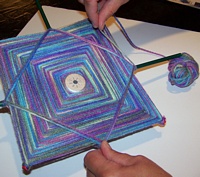 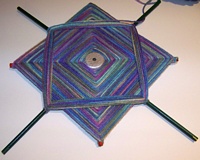 |
 |
Tips and Tricks:
If you don't have enough rods from an old
Tinkertoy set, use ¼ inch dowel rods bought from a lumber yard or
hardware store. Just cut each dowel rod into the sizes described
above.
It's important to tightly wrap the yarn
around each rod, but too much pressure will cause the sticks to bend.
Remember to wrap up tails on loose ends in
the weaving. This will help keep them from showing, and it will make the God's
Eye stronger.
If you're left-handed, wrap the yarn going in
a counterclockwise direction, or to your left instead of your
right.
If you'd like to decorate the spool, have an
adult use the hot glue gun to fasten a bead or button to the center.
To make a design that's in the shape of an
octagon, weave around all eight sticks at one time.
If you prefer making the more traditional
God's Eyes, use plain yarn. To change colors, just end one color and start
another by tying the yarn onto the sticks, being careful to wrap up the tails
in the weaving. Continue weaving until you've added five colors to the
framework.
To make smaller versions of God's Eyes, wrap
scrap yarn or leftover pieces of embroidery floss around two toothpicks or
Q-tips. Lash together in the center, begin weaving, and when finished, hang
from a loop.
Visit the
National Toy Hall of
Fame, which is located in the Strong-National Museum of Play in Rochester,
New York, to learn more about Tinkertoys and others that have been recognized
for their importance in encouraging kids to use their imaginations when playing
with toys.
© 2008 Marilyn J. Brackney (updated 2018)
Volume 21 No. 3
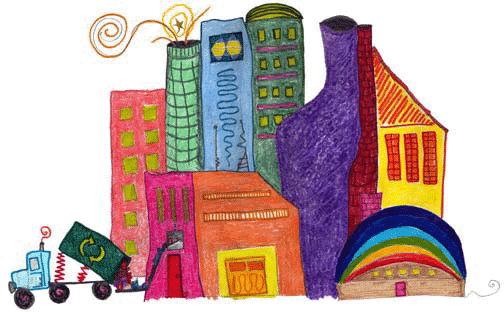
Return to Main Web Page
Return to the main holidays Page
Select this to
choose other holiday activities..

![]() Also known as an Ojo de Dios (pronounced Oh-ho day
DEE-ohs), this traditional Mexican ornament is made by wrapping yarn around two
sticks made into a cross shape. The simple weaving is thought to have
originated with the Huichol Indians of Mexico, but God's Eyes have been found
in Africa and in the Far East, as well. Symbolizing the loving, watchful eye of
a god, the ancient design is thought to bring good luck.
Also known as an Ojo de Dios (pronounced Oh-ho day
DEE-ohs), this traditional Mexican ornament is made by wrapping yarn around two
sticks made into a cross shape. The simple weaving is thought to have
originated with the Huichol Indians of Mexico, but God's Eyes have been found
in Africa and in the Far East, as well. Symbolizing the loving, watchful eye of
a god, the ancient design is thought to bring good luck. ![]() In the Huichol culture, a child's birth is
celebrated by the father weaving a central eye around the sticks, and then an
eye in the form of a new color is added each year until the child is five years
old. Originally placed on altars to watch over the worshipers, the weavings
eventually were hung in homes in hopes of blessing children with good health
and long lives. Today, God's Eyes are found in cultures all over the world, and
people often use them to decorate Christmas trees.
In the Huichol culture, a child's birth is
celebrated by the father weaving a central eye around the sticks, and then an
eye in the form of a new color is added each year until the child is five years
old. Originally placed on altars to watch over the worshipers, the weavings
eventually were hung in homes in hopes of blessing children with good health
and long lives. Today, God's Eyes are found in cultures all over the world, and
people often use them to decorate Christmas trees.